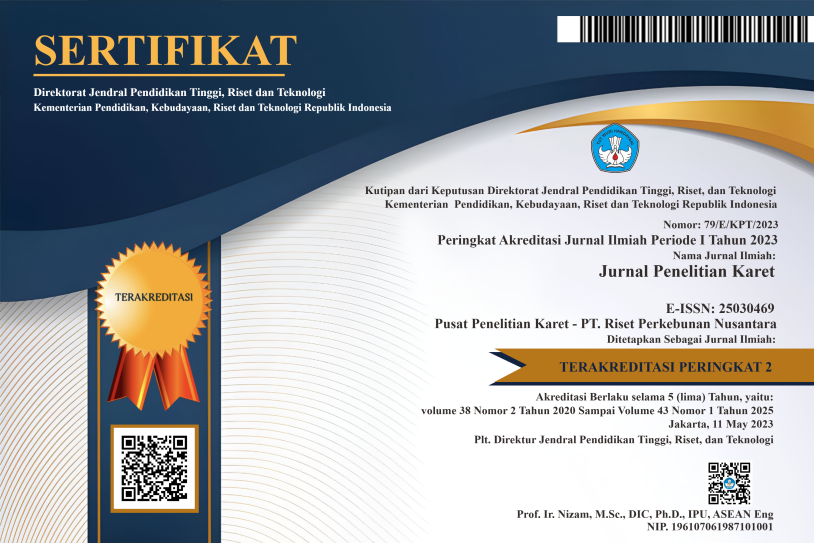APLIKASI TEKNIK PLASMA SOLUSI PADA PRODUKSI KARET ALAM TERDEPROTEINASI (DPNR)
DOI:
https://doi.org/10.22302/ppk.jpk.v41i1.836Keywords:
deproteinasi karet alam, plasma solusi, proteinAbstract
Karet alam terdeproteinasi (DPNR) diproduksi untuk memenuhi kebutuhan persyaratan produk untuk gangguan alergi protein dan proses modifikasi partikel karet alam. DPNR dibuat dengan teknik plasma solusi dengan pengaplikasian beberapa nilai voltase yaitu 1, 5, dan 10 kV untuk mengamati degradasi tertinggi bagian non-karet di DPNR. DPNR yang dihasilkan melalui plasma solusi dengan voltase tegangan 1, 5, dan 10 kV selanjutnya disebut DPNR 1 kV, DPNR 5 kV, dan DPNR 10 kV. Degradasi bagian non-karet ditentukan menggunakan Fourier Transform Infra-Red (FT-IR), pengujian kadar nitrogen, kandungan gel, dan viskositas. DPNR 10 kV memiliki nilai rasio puncak protein dan kadar nitrogen terendah sebesar 65,9% protein karet terdegradasi. Hasil ini menunjukkan bahwa voltase 10 kV merupakan kondisi optimum untuk mendegradasi protein dengan teknik plasma solusi.
References
Aik-Hwee, E., Kawahara, S., & Tanaka, Y. (1993). Determination of low nitrogen content of purified natural rubber. Journal of Natural Rubber Research, 8, 109-109.
Amnuaypornsri, S., Nimpaiboon, A., & Sakdapipanich, J. (2009). Role of phospholipids and proteins on gel formation and physical properties of NR during accelerated storage. Kgk Kautschuk Gummi Kunststoffe, 62(3), 88.
Archer, B., & Sekhar, B. (1955). The proteins of Hevea brasiliensis latex. 1. Protein constituents of fresh latex serum. Biochemical Journal, 61(3), 503-508.
Chaikumpollert, O., Sae-Heng, K., Wakisaka, O., Mase, A., Yamamoto, Y., & Kawahara, S. (2011). Low temperature degradation and characterization of natural rubber. Polymer Degradation and Stability, 96(11), 1989-1995.
Dinsmore, H., & Smith, D. C. (1948). Analysis of natural and synthetic rubber by infrared spectroscopy. Analytical Chemistry, 20(1), 11-24.
Giguère, P. A. (1950). The infra-red spectrum of hydrogen peroxide. The Journal of Chemical Physics, 18(1), 88-92.
Goossens, J., & Vogt, H. (1990). The coagulation mechanism of heat sensitive latices. Colloids and Surfaces, 51, 129-139.
Imprastitichai, K., Thanawan, S., & Suchiva, K. (2009). Preparation and characterizations on natural rubber from natural rubber latex by using thermal drying method. KKU Research Journal (Graduate Studies), 9(2), 59-64.
Kinasih, N. A., Fathurrohman, M. I., & Winarto, D. A. (2017). Swelling behaviour in n-pentane and mechanical properties of epoxidized natural rubber with different epoxide content. IOP Conference Series: Materials Science and Engineering, 223, 012002. doi:10.1088/1757-899x/223/1/012002
Kinasih, N. A., & Magaraphan, R. (2021). Characterization of epoxidized natural rubber based on deproteinized natural rubber prepared with solution plasma technique. PPC & Petromat Symposium 2021, 8.
Klinklai, W., Kawahara, S., Mizumo, T., Yoshizawa, M., Sakdapipanich, J. T., Isono, Y., & Ohno, H. (2003). Depolymerization and ionic conductivity of enzymatically deproteinized natural rubber having epoxy group. European Polymer Journal, 39(8), 1707-1712.
Kovuttikulrangsie, S., Sahakaro, K., Intarakong, C., & Klinpituksa, P. (2004). PMMA blended and DPNR g PMMA coated DPNR and NRLA for dipping applications. Journal of Applied Polymer Science, 93(2), 833-844.
Liengprayoon, S., Vaysse, L., Jantarasunthorn, S., Wadeesirisak, K., Chaiyut, J., Srisomboon, S., Musigamart, N., Roytrakul, S., Bonfils, F., Char, C., & Bottier, C. (2021). Distribution of the non-isoprene components in the four Hevea brasiliensis latex centrifugation fractions. Journal of Rubber Research, 24(5), 759-769.
Lu, F., & Hsu, S. (1987). A vibrational spectroscopic analysis of the structure of natural rubber. Rubber Chemistry and Technology, 60(4), 647-658.
Ma, F., Wang, Z., Zhao, H., & Tian, S. (2012). Plasma depolymerization of chitosan in the presence of hydrogen peroxide. International Journal of Molecular Sciences, 13(6), 7788-7797.
Mahendra, I. P., Linh, M. K., Thang, N. N., Thuy, V. T., Trang, L. T., Thinh, Phuong, N. T. H., Kawahara, S., Yamamoto, Y., & Nghia, T. T. (2021). Protein removal from natural rubber latex with Fe3O4@ Al2O3 nanoparticle. Journal of the Brazilian Chemical Society, 32(2), 320-328.
Malik, M. A., Ghaffar, A., & Malik, S. A. (2001). Water purification by electrical discharges. Plasma Sources Science and Technology, 10(1), 82-91. doi:10.1088/0963-0252/10/1/311
Manroshan, S., Asrul, M., Vivayganathan, K., Mok, K.L., & Lim, E. (2008). The Effects of Surfactants in Deproteinized Natural Rubber Latex. Paper presented at the. 4th International Rubber Glove Conference & Exhibition 2008. Kuala Lumpur, Malaysia.
Markovi?, G., Marinovi?-Cincovi?, M., Jovanovi?, V., Samaržija-Jovanovi?, S., & Budinski-Simendi?, J. (2013). NR/CSM/biogenic silica rubber blend composites. Composites Part B: Engineering, 55, 368-373.
Morishita, T., Ueno, T., Panomsuwan, G., Hieda, J., Yoshida, A., Bratescu, M. A., & Saito, N. (2016). Fastest formation routes of nanocarbons in solution plasma processes. Scientific Reports, 6(1), 1-13.
Nallasamy, P., & Mohan, S. (2004). Vibrational spectra of cis-1, 4-polyisoprene. Arabian Journal for Science and Engineering, 29(1; PART A), 17-26.
Nawamawat, K., Sakdapipanich, J. T., & Ho, C. C. (2010). Effect of deproteinized methods on the proteins and properties of natural rubber latex during storage. Paper presented at the Macromolecular Symposia.
Nawamawat, K., Sakdapipanich, J. T., Ho, C. C., Ma, Y., Song, J., & Vancso, J. G. (2011). Surface nanostructure of Hevea brasiliensis natural rubber latex particles. Colloids and Surfaces A: Physicochemical and Engineering Aspects, 390(1), 157-166. doi:https://doi.org/10.1016/j.colsurfa.2011.09.021
Ng, S.-C., & Gan, L.-H. (1981). Reaction of natural rubber latex with performic acid. European Polymer Journal, 17(10), 1073-1077.
Ng, Y. T. (1992). RRIM test methods for standard Malaysian rubbers. Malaysia: Rubber Research Institute of Malaysia.
Nun-anan, P., Wisunthorn, S., Pichaiyut, S., Vennemann, N., & Nakason, C. (2018). Novel approach to determine non-rubber content in Hevea brasiliensis: Influence of clone variation on properties of un-vulcanized natural rubber. Industrial Crops and Products, 118, 38-47.
Pornsunthorntawee, O., Katepetch, C., Vanichvattanadecha, C., Saito, N., & Rujiravanit, R. (2014). Depolymerization of chitosan-metal complexes via a solution plasma technique. Carbohydrate Polymers, 102, 504-512. doi:10.1016/j.carbpol.2013.11.025
Prasertsung, I., Damrongsakkul, S., Terashima, C., Saito, N., & Takai, O. (2012). Preparation of low molecular weight chitosan using solution plasma system. Carbohydrate Polymers, 87(4), 2745-2749. doi:https://doi.org/10.1016/j.carbpol.2011.11.055
Rodebush, W., Keizer, C., McKee, F. S., & Quagliano, J. (1947). The reactions of the hydroxyl radical1. Journal of the American Chemical Society, 69(3), 538-540.
Rodebush, W., & Wahl, M. (1933). The reactions of the hydroxyl radical in the electrodeless discharge in water vapor. The Journal of Chemical Physics, 1(10), 696-702.
Sansatsadeekul, J., Sakdapipanich, J., & Rojruthai, P. (2011). Characterization of associated proteins and phospholipids in natural rubber latex. J Biosci Bioeng, 111(6), 628-634. doi:10.1016/j.jbiosc.2011.01.013
Tanaka, Y. (2001). Structural characterization of natural polyisoprenes: solve the mystery of natural rubber based on structural study. Rubber Chemistry and Technology, 74(3), 355-375.
Tangpakdee, J. (1997). Purification of natural rubber. J. Nat. Rubber Res., 12, 112-119.
Tarachiwin, L., Sakdapipanich, J., Ute, K., Kitayama, T., Bamba, T., Fukusaki, E., Kobayashi, A., & Tanaka, Y. (2005). Structural characterization of ?-terminal group of natural rubber. 1. decomposition of branch-points by lipase and phosphatase treatments. Biomacromolecules, 6(4), 1851-1857. doi:10.1021/bm058003x
Varghese, S., Katsumura, Y., Makuuchi, K., & Yoshii, F. (2000). Production of soluble protein free latex by radiation process. Rubber Chemistry and Technology, 73(1), 80-88.
Wei, Y.-C., Xia, J.-H., Zhang, L., Zheng, T.-T., & Liao, S. (2020). Influence of non-rubber components on film formation behavior of natural rubber latex. Colloid and Polymer Science, 298(9), 1263-1271.
Wong, P., & Mantsch, H. (1988). High-pressure infrared spectroscopic evidence of water binding sites in 1, 2-diacyl phospholipids. Chemistry and Physics of Lipids, 46(3), 213-224.
Xu, L., Huang, C., Luo, M., Qu, W., Liu, H., Gu, Z., Jing, L., Huang, G., & Zheng, J. (2015). A rheological study on non-rubber component networks in natural rubber. Rsc Advances, 5(111), 91742-91750.
Yamamoto, Y., Sawada, T., & Kawahara, S. (2007). Graft-copolymerization of acrylonitrile onto surfaces of natural rubber particles using deproteinized natural rubber latex. Kobunshi Ronbunshu, 64(3), 155-160.
Yapa, P., & Fernando, W. (1998). Enhancement of deproteinization of Hevea rubber by maturation of papain treated Hevea latex. Vidyodaya J. of Sci., 7, 93-100.
Yusof, N. H., Darji, D., Rasdi, F. R. M., & Nesan, K. V. B. (2021). Preparation and characterisation of liquid epoxidised natural rubber in latex stage by chemical degradation. Journal of Rubber Research, 24(1), 93-106.
Downloads
Published
How to Cite
Issue
Section
License
Copyright (c) 2023 Norma Arisanti Kinasih, Rathanawan Magaraphan

This work is licensed under a Creative Commons Attribution-ShareAlike 4.0 International License.
Submission of a original research article in Jurnal Penelitian Karet implies that the submitted  manuscript has not been published in any scientific journal (except being part of the abstract, thesis, or report). The submitted manuscript also is not under consideration for publication elsewhere. All co-authors involve in the publication of the manuscript should give their approval.
Once, the manuscript is accepted and then published in Jurnal penelitian Karet, the Author(s) keep hold the copyright and retain publishing right without restrictions.
Author(s) and Jurnal Penelitian Karet users are allowed to multiply the published manuscript. The journal users are also permissible to share the published manuscript with an acknowledgement to the Author(s). The Editorial Boards suggest that the Authors should manage patent before publishing their new inventions.
















